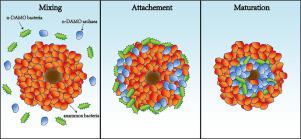Water Research ( IF 11.4 ) Pub Date : 2021-02-23 , DOI: 10.1016/j.watres.2021.116963 Chunshuang Liu , Tao Liu , Xiaoying Zheng , Jia Meng , Hui Chen , Zhiguo Yuan , Shihu Hu , Jianhua Guo

|
Granular sludge exhibits unique features, including rapid settling velocity, high loading rate and relative insensitivity against inhibitors, thus being a favorable platform for the cultivation of slow-growing and vulnerable microorganisms, such as anaerobic ammonium oxidation (anammox) bacteria and nitrite/nitrate-dependent anaerobic methane oxidation (n-DAMO) microorganisms. While anammox granules have been widely applied, little is known about how to speed up the granulation process of n-DAMO microorganisms, which grow even slower than anammox bacteria. In this study, we used mature anammox granules as biotic carriers to embed n-DAMO microorganisms, which obtained combined anammox + n-DAMO granules within 6 months. The results of whole-granule 16S rRNA gene amplicon sequencing showed the coexistence of anammox bacteria, n-DAMO bacteria and n-DAMO archaea. The microbial stratification along granule radius was further elucidated by cryosection-16S rRNA gene amplicon sequencing, showing the dominance of n-DAMO archaea and anammox bacteria at inner and outer layers, respectively. Moreover, the images of cryosection-fluorescence in situ hybridization (FISH) verified this stratification and also indicated a shift in microbial stratification. Specifically, n-DAMO bacteria and n-DAMO archaea attached to the anammox granule surface initially, which moved to the inner layer after 4-months operation. On the basis of combined anammox + n-DAMO granules, a practically useful nitrogen removal rate (1.0 kg N/m3/d) was obtained from sidestream wastewater, which provides new avenue to remove nitrogen from wastewater using methane as carbon source.
中文翻译:

快速形成结合n-DAMO和厌氧氨氧化菌微生物的颗粒以去除氮
颗粒状污泥具有独特的功能,包括沉降速度快,负载速率高以及对抑制剂的相对不敏感性,因此是培养缓慢生长和易感染微生物的理想平台,例如厌氧铵氧化(anammox)细菌和亚硝酸盐/硝酸盐。依赖的厌氧甲烷氧化(n-DAMO)微生物。尽管厌氧氨纶颗粒已被广泛应用,但如何加速正-厌氧氨氧化菌的成粒过程却知之甚少,后者的生长速度甚至比厌氧氨氧化菌要慢。在这项研究中,我们使用成熟的厌氧氨氧化颗粒作为生物载体来包埋n-DAMO微生物,从而获得了厌氧氨纶+ n的组合 -DAMO颗粒在6个月内。全颗粒16S rRNA基因扩增子测序结果表明,厌氧细菌,n-DAMO细菌和n-DAMO古细菌并存。冷冻切片-16S rRNA基因扩增子测序进一步阐明了沿颗粒半径的微生物分层,分别显示了内层和外层的n-DAMO古细菌和厌氧菌占主导地位。此外,冷冻切片-荧光原位杂交(FISH)图像验证了这种分层,也表明了微生物分层的转变。具体而言,n-DAMO细菌和n-DAMO古细菌最初附着于厌氧菌颗粒表面,在操作4个月后移至内层。在组合厌氧菌+ n的基础上 -DAMO颗粒,从侧流废水中获得了实用的脱氮率(1.0 kg N / m 3 / d),这为使用甲烷作为碳源从废水中脱氮提供了新途径。











































 京公网安备 11010802027423号
京公网安备 11010802027423号